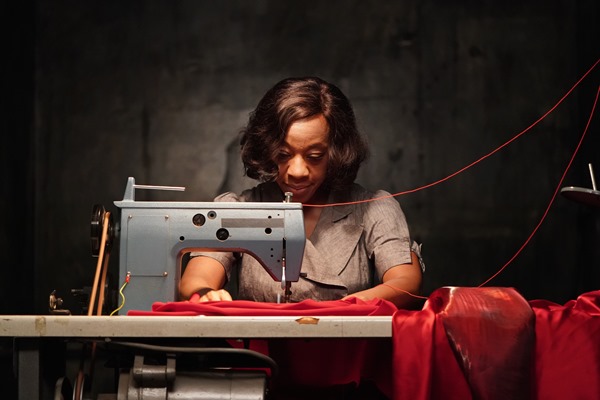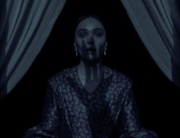
Director Peter Strickland is a fetishist of the extreme variety. He fetishizes everything. Fetishism is, in a sense, to control. It’s to take a particular object, isolate it, and focus solely on it, to the exclusion of anything else. A foot fetishist, for example, is little interested in the owner of that foot.
Strickland’s fetish is film, and he fetishizes whatever is in his frame, and each shot is perfectly composed to an unnerving degree. The downside of this approach is occasionally his work can seem fussy and overly controlled. That is what sunk The Duke of Burgundy. As lovely as it looked and as wonderful as the actors were, there was no space to worm into that world.
I am happy to say that In Fabric does not suffer from fussiness. In fact, it is generous in its humor (which there is plenty) and sympathetic toward its (mostly doomed) characters. It is also bat-shit crazy. Strickland has let his imagination run wild and given us a film with a fairly basic, easy to follow through line, but he embellishes it with odd tangents, pungently weird images, and a fierce attack on high-end fashion, all topped an ironic bow. You can practically hear him chuckling to himself while you try to work out the mystery at the heart of the story.
The main character is a murderous red dress. Its motives are unclear, but it leaves a path of destruction wherever it goes. The first half focuses on a practical and lonely middle-aged woman, Sheila (the indispensable Marianne Jean-Baptiste). She has a son Vince (Jaygann Ayeh), a painter possibly in his late teens or early 20s. They have affection for each other, but Vince, as young sons do, rebels by bringing his older, statuesque girlfriend, Gwen (Game of Thrones’ Gwendoline Christie), for some modeling and eventually, ah, noisy activities. Sheila, who is divorced and lonely, is jealous of Vince’s peccadilloes, and has been answering singles ads in the newspaper—the film seems to be set in the early to mid-1980s. She receives a response and decides to buy a new dress for the occasion.
Enter Dentley & Soper’s, a department store that would win Tim Burton’s approval. It’s staffed by women with dyed black hair wearing black Victorian dresses and overseen by a fairly ancient man, Mr. Lundy (Richard Bremmer), and head clerk Jill (Sidse Babett Knudsen). The commercial for the store is reminiscent of an early out-there ’80s music video, and the store design recalls various haute couture clothing shops, but the help all speak in excruciatingly heightened language emphasizing the emotional needs that the purchase at hand will fulfill. The first sold laugh centers on the juxtaposition of Jill’s erudite sales pitch against Sheila’s more working-class pragmatism.
Sheila, of course, buys the dress, and the date is a disaster. Sheila feels no better and doesn’t get a hit of self-esteem, but mysterious things do happen. There’s a washer machine situation, also hysterical, and the dress hovers over her as she sleeps.
It should be noted that the bank that Sheila works in is quite odd as well. Overseen by two middle managers, Stash and Clive (the archly funny Julian Barratt and Steve Oram), they pull Sheila aside to quiz her about her dreams and toilet habits and give odd bits of advice. They are just two more in this odd universe Strickland guides us through.
If the director just stuck to Sheila’s story, he may have had a masterpiece on his hands. It is arch, funny, creepy, weird, thought provoking, beautifully acted, and impeccably staged. Unfortunately, you realize the movie won’t be about Sheila so much as it will be about the dress. I won’t reveal Sheila’s fate, except to say that it isn’t great.
The second half focuses on a young, engaged couple: washing machine repairman Reg (Leo Bill) and his fiancé, Babs (Hayley Squires). The dress comes to Reg’s possession at a bachelor party, where he is forced to wear it, and he takes it home. Somehow, the garment also fits Babs. This is bad luck for both of them. However, Reg and Babs are far more of a caricature than Sheila, which makes their story less involving, but also more humorous. At one point, Reg recounts a dream about watching his wife give birth and the newly born baby lets Reg know exactly how he feels about him, giving dad the finger.
The biggest problem with this section is that it pretty much follows the same beats as Sheila’s story, so there are few surprises. There are encore performances from Stash and Clive and a revisit to Dentley & Soper’s. It’s pretty much the same film twice. The acting is just as good, and the humor is intact. It just adds little to the mythology that Strickland has created, though he ties the ending together with a lovely “a-ha!” moment.
For The Duke of Burgundy, Strickland clearly had his eye on soft-core ’70’s European erotica. Here, he seems to have cribbed quite a bit from Dario Argento and giallo films in general, tossed with some David Lynch for good measure, and wrapped it up in a pair of kitchen-sink dramas.
But Peter Strickland is a unique director. Any style he emulates will be filtered through his lens, and what you end up with is uniquely a Peter Strickland film. He is a very, very acquired taste, but he is certainly a taste worth acquiring.






Leave A Comment